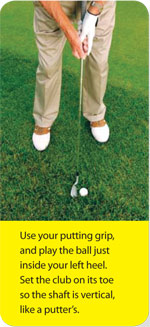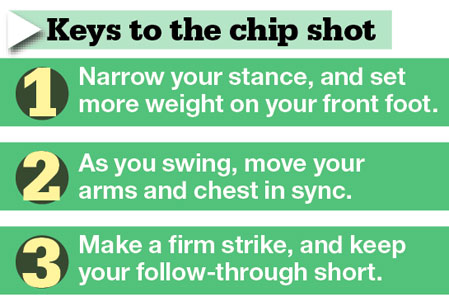GOLFDIGEST 12/2010 bringt einen hervorragenden Artikel von Butch Harmon über das kurze Spiel, das wir Dir nicht vorenthalten wollen. Wenn Du Dir die im Artikel beschriebenen Techniken aneignest und gut praktizierst, vor allem die beschriebenen Fehler vermeidest, wird sich Dein Score wesentlich verbessern.
5 SHOTS TO SAVE YOUR GAME
By Butch Harmon, Golf Digest teaching professional
With Peter Morrice
Photos by J.D. Cuban
1. THE SOFT LOB
Swing Long And Lazy
Every golfer wants to be able to hit the lob shot; the smart ones use it only when no other shot will do. The first thing you have to realize is that you need a decent lie–a little cushion under the ball–to have a good chance of pulling it off.
Take your most lofted wedge, play the ball just forward of center and open the clubface. (For extra loft, weaken your left-hand grip by setting your left thumb on top of the handle instead of down the right side.) The open face will let you slide the club under the ball without the toe turning over through impact.
Swing back about three-quarters, and make a gradually accelerating pass through the ball. The open face will send the ball high, so commit to accelerating. Don’t think about hitting the ball: Make a long, smooth swing, and turn your body to the target.
• KEY MOVE
Swing to a full finish, with your weight on your front foot. When the clubface is open, you need a long swing to apply enough power to get the ball to the hole.
• COMMON FAULT
Trying to lift the ball, many golfers fall back and flip the club up. This leads to chunks or skulls. Shift to your left, and turn through, trusting the loft on the clubface.
2. PITCH-AND-RUN
Hit It With Firm Wrists
With a fairway lie and plenty of green to work with, the pitch-and-run is the best shot to play. There’s no reason to fly the ball all the way to the hole–even if you do see the pros doing it on TV.
Using your 9-iron or wedge, play the ball middle to slightly back in your stance and push your hands and weight forward. Get a clear focus on where you want to land the ball to run it to the hole. (It’s a good idea to carry it onto the green for a predictable bounce.) Swing the club straight back about halfway, and accelerate into the back of the ball, finishing with your arms and club pointing at the hole.
Think of this as an arms-and-body swing: Turn your body and swing your arms through together. Resist the urge to help the shot at impact with your hands.
• KEY MOVE
Use minimal wrist hinge on the backswing. Unhinging adds swing speed, making it tougher to judge the distance of the shot.
• COMMON FAULT
Even from 30 or 40 yards, I see some players making a full backswing. Then they realize they’ve created too much swing, so they ease off on the way down and usually mis-hit the shot.
3. SHORT-SIDED POP
Hold The Clubface Open
When you miss a green on the same side as the hole, you’re left with a touchy little shot that’s easy to leave in the grass or chip too far. The secret is making solid contact and controlling the amount of hit you put on the ball.
Pick your most lofted wedge, and play the ball back in your stance with the clubface square or slightly open. Take a narrow stance with your weight forward and your hands well ahead of the clubhead.
From there, make a firm little swing, dropping the clubhead behind the ball. You’re trying to just pop it forward, so don’t worry about swinging through. And don’t let the clubface close through impact; that takes the loft–and softness–out of the shot. The correct feel is, you’re hitting it with the back of your left hand.
• KEY MOVE
At address, lean on your front foot and angle the shaft forward. Your priority is to hit the ball solid, and because the swing is so short, these setup positions will do it.
• COMMON FAULT
Amateurs tend to play the ball forward and set their weight back. They think they can hit a softer shot this way, but they usually catch it fat or thin.
4. DEEP-ROUGH CHIP
Make A Steep Swing
Digging the ball out of a buried lie and hitting it with touch might seem like an impossible combination, but it’s not. You have to understand that you’re going to trap some grass between the clubface and the ball at impact. The trick is catching the ball as cleanly as you can.
Your sand wedge is the best choice here because you can use the extra weight in the sole to slide the clubface under the ball. With your weight forward, play the ball in the middle of your stance, and make a steep backswing by hinging your wrists right off the ball.
• KEY MOVE
To create the correct motion, picture the letter V: The steeper you swing the club back and down, the higher the ball will pop out on the other side.
• COMMON FAULT
If you don’t hinge your wrists going back, you’ll make a shallow swing into the ball. As a result, the clubhead will catch too much grass before impact.
On the downswing, throw the clubhead into the grass behind the ball. Don’t think about making a follow-through–the resistance of the heavy grass will slow the momentum of the club.
5. BUNKER BLAST
Slap It With The Right Hand
With a bunker lip to get over, you need clubface loft and swing speed to create height. Your first priority is putting the ball on the green; second is getting it close.
Use your lob or sand wedge, and play the ball forward, opposite your front instep, so the club can enter the sand a couple of inches behind the ball. Swing back about three-quarters, and accelerate the club into and through the sand.
Don’t cut across the ball, as you’ve probably been told; that only adds sidespin. Swing out to the flag. It’s a very right-handed swing: Feel as if you’re slapping the sand with your right hand.
• KEY MOVE
For more loft, angle the shaft away from the target at address. To do this, move the ball forward but keep your hands in line with the inside of your front leg.
• COMMON FAULT
Many players try to open the face by pushing the grip toward the target and turning the right hand under. This exposes the hosel, leading to thin shots or shanks.

 Setting the club with the heel off the ground:
Setting the club with the heel off the ground:

